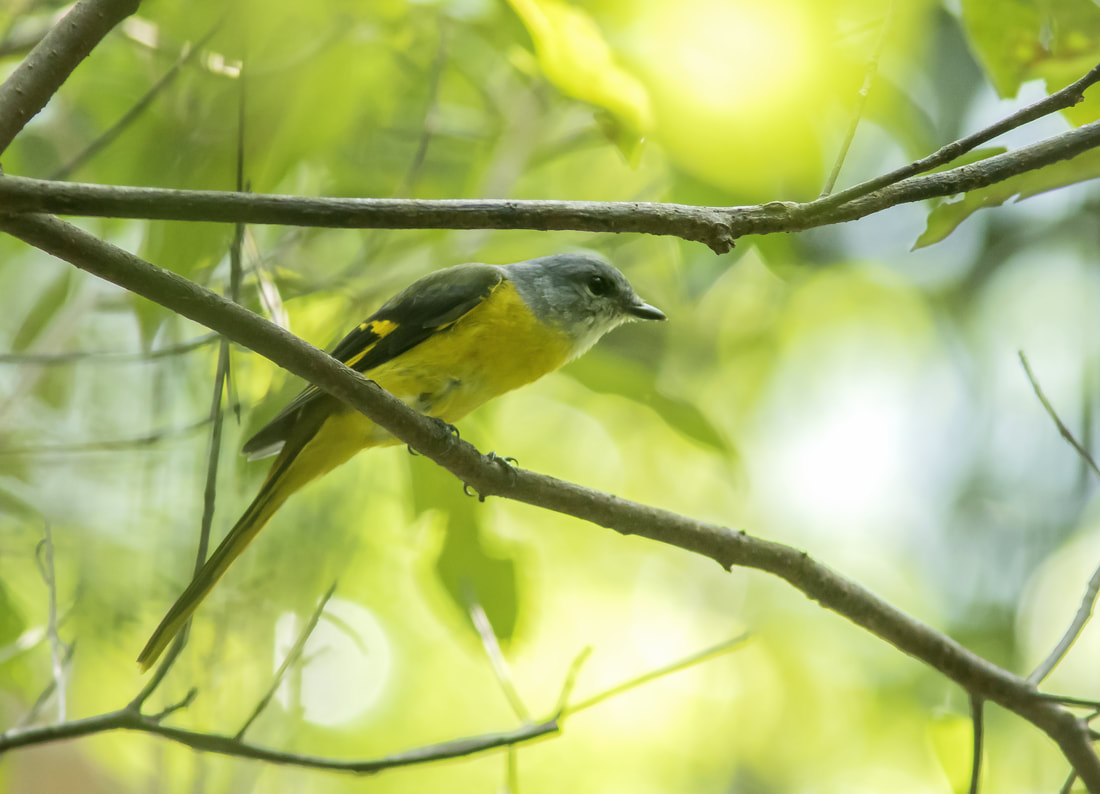|
I went to Tai Po Kau on October 12th, arriving at Tai Po Kau Park just before 7.00 a.m. I often visit this park before going to the main forest reserve. It is best early in the morning, particularly when the sun rises above the adjacent hills and begins to illuminate the trees in the park. The park is good for a number of common generalist species – Red-whiskered Bulbul, Japanese White-eye, Common Tailorbird, Cinereous Tit and Oriental Magpie Robin - as well as being a site to pick up a number of the resident forest birds. This morning I was lucky and managed to connect with Scarlet and Grey-chinned Minivets, Orange-bellied Leafbird, Yellow-cheeked Tit, Blue-winged Minla, Velvet-fronted Nuthatch and Fork-tailed Sunbird. The park is the best place in the area to see Great Barbet as sometimes it comes down from the hillsides to feed on fruiting trees. It is not always present, but today I heard its throaty rasping call and managed to get a quick glimpse of it in overhead branches. My first bird of the day, however, was a migrant flycatcher with dark markings across the breast perched on a fence below the western end of the park; unfortunately my views were brief and inadequate so I could not be sure whether it was a Grey-streaked or Dark-sided Flycatcher. I did manage to identify a few other migrants in the park, namely Asian Brown Flycatcher, a couple of Yellow-browed Warblers, Ashy Drongo and Black-winged Cuckooshrike. The latter two species winter here and will be present from now through until next April. Aside from the birds, I came across a Bamboo Pit Viper; it was on the ground under a small shelter next to a dead Brown Forest Skink which I assume it had killed. Unlike most snake species that move away once they are aware of a human presence, the viper remained under the shelter for the following half hour. I kept a little distance as the species is venomous, although there are no known fatalities from its bite in Hong Kong. I spent a couple of hours in the park, although activity became quieter after 8.00 a.m. Then I walked up the access road into the forest. I had heard Mountain Tailorbird singing near the park and there were more singing as I made my way uphill. This species was first recorded in 1999 and has since become widespread with sightings from at least 42 locations in 2013. When you are familiar with its song, you notice how common it is at Tai Po Kau: I heard 19 in total during the morning . Other birds I saw along the road were two Black-throated Laughingthrushes, Rufous-capped Babbler, and a female Fire-breasted Flowerpecker. I took a clockwise route along the red walk and included the blue walk loop. These colour-coded walks are along narrow trails inside the forest. Birding here can be very hit-and-miss. Bird density is generally low and the hope in the enclosed space is to come across a bird wave. There are, however, ground-haunting birds on territory and I heard singing Lesser Shortwing and Pygmy Wren Babbler between the dam and the second picnic area. Like the Mountain Tailorbird, these two species are recent additions to the Hong Kong avifauna. Lesser Shortwing was first recorded in 1998, Pygmy Wren Babbler in 2001. Like the tailorbird, they are now well-established in Hong Kong, particularly in the forests of the New Territories. The red walk proved disappointingly quiet. There was a small bird wave just after the 2nd picnic area but for the most part the birds remained invisible some distance off in the trees. I saw Huet’s Fulvetta and heard minivets, white-eyes, nuthatches and Chestnut Bulbuls. I came across a second wave after I had done the blue walk loop and was near to reconnecting with the red walk. Frustratingly the birds remained high in the trees and seemed to be much the same species as before. A little further along the red walk I chanced upon a loose party of 20 Grey-chinned Minivets feeding in the trees adjacent to the trails; they, at least, gave good views. I also came across two more Lesser Shortwings, loud but invisible in the undergrowth. Apart from these it was hot and quiet and there were no migrants to be seen. Back below the dam, I paused at the stream to admire the striking Common Blue Jewel damselflies on the rocks. I heard and had brief views of a Pale-legged/Sakhalin Leaf Warbler as it flew across the stream into the vegetation. My final new sighting for the day on the way back down the access road was of two Streak-breasted Scimitar Babblers feeding low in vegetation with Rufous-capped Babblers.
0 Comments
|






 RSS Feed
RSS Feed
